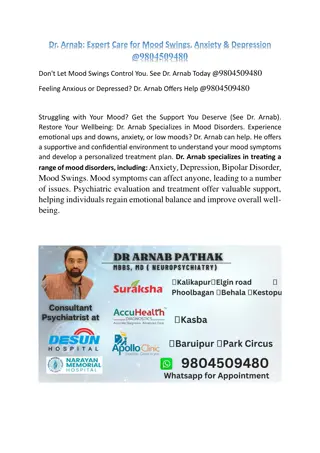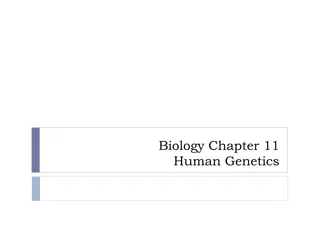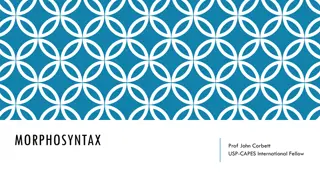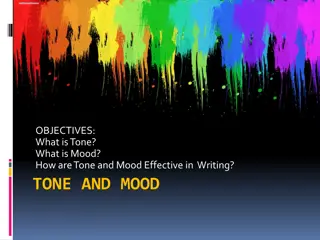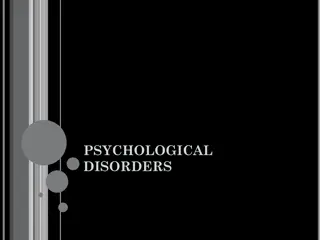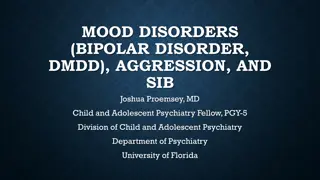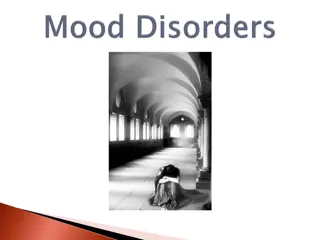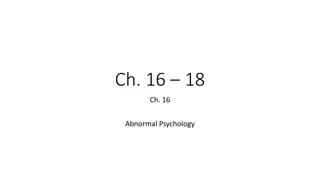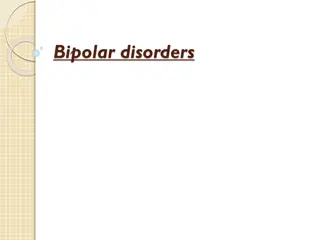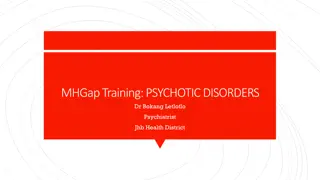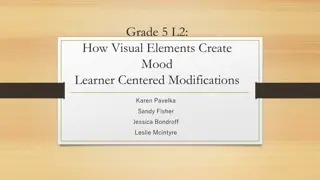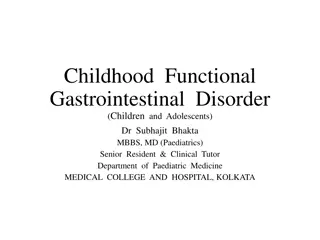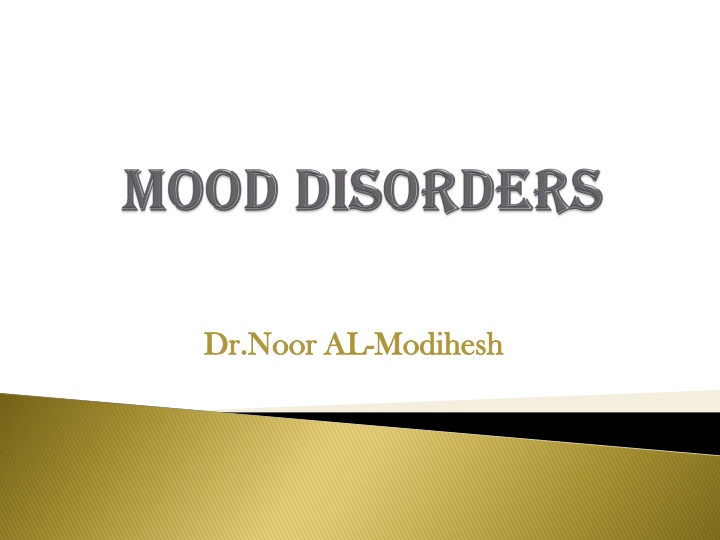
Mood Disorders: Symptoms, Prevalence, and Diagnosis
Mood disorders like Major Depressive Episode (MDE) and Major Depressive Disorder (MDD) have significant impacts on individuals' mental health. Learn about the symptoms, prevalence, and diagnostic criteria associated with these conditions.
Download Presentation

Please find below an Image/Link to download the presentation.
The content on the website is provided AS IS for your information and personal use only. It may not be sold, licensed, or shared on other websites without obtaining consent from the author. If you encounter any issues during the download, it is possible that the publisher has removed the file from their server.
You are allowed to download the files provided on this website for personal or commercial use, subject to the condition that they are used lawfully. All files are the property of their respective owners.
The content on the website is provided AS IS for your information and personal use only. It may not be sold, licensed, or shared on other websites without obtaining consent from the author.
E N D
Presentation Transcript
Dr. Dr.Noor Noor AL AL- -Modihesh Modihesh
Mood is the sustained and pervasive feeling tone that influences a person's behavior and perception of the world. It is internally experienced. Mood can be normal, depressed, or elevated. Affect is the person's present transient emotional state. It represents the external expression of mood. Subjective Vs Objective
1.Major depressive episode (MDE): 2 weeks of low mood/loss of interest + other features 2.Manic episode: 1 week of elevated, expansive, or irritable mood + other features 3.Mixed episode: 1 week of both depressed and manic mood + other features 4.Hypomanic episode: 4 days less severe elevated mood + other features 5.Dysthymic disorder: 2 year-history of chronic less severe low mood. 6.Cyclothymic disorder: Less severe bipolar mood disorder with continuous mood swings; alternating periods of hypomania and moderate depression.
Mood For Major Depressive Episode: least five of nine symptoms of depression they must be present for at least 2 weeks to rule out transient mood fluctuations. must cause distress or impairment. Other conditions must be ruled out Is it MDE or MDD ? Any significance ? Mood disorders have a high prevalence. For Major Depressive Episode: disorders have a high prevalence. Is it MDE or MDD ? Any significance ?
Lifetime risk is in the range of 10 - 15 %. Lifetime prevalence is in the range of 15 25%. The mean age of onset is about 40 years (25 - 50 years).
Major Depressive Episode persistent depressed mood and the inability to anticipate happiness or pleasure. more persistent and not tied to specific thoughts or Preoccupations. self-critical or pessimistic ruminations. possibly about joining the deceased Major Depressive Episode Grief Grief Predominant feature is emptiness & sense of loss. dysphoria in grief decreases over days & weeks thoughts and memories of the deceased. self-esteem is generally preserved possibly about joining the deceased
In DSM Disruptive mood dysregulation disorder Major depressive disorder, single episode Major depressive disorder, recurrent Persistent depressive disorder (dysthymia) Substance/medication-induced depressive disorder Premenstrual dysphoric disorder Depressive disorder due to another medical condition Other specified depressive disorder Unspecified depressive disorder In DSM5 5 : :
Neglected dress and grooming. Facial appearance of sadness: - Turning downwards of corners of the mouth. - Down cast gaze/tearful eyes/reduced rate of blinking. - Head is inclined forwards. /tearful eyes/reduced rate of blinking. Psychomotor retardation (in some patients agitation occurs): - Lack of motivation and initiation. - Slow movements/slow interactions. /slow interactions. Social isolation and withdrawal. Delay of tasks and decisions.
Change in appetite (usually reduced but in some patients increased). Change in sleep (usually reduced but in some patients increased). Early morning (terminal) insomnia; waking 2 - 3 hours before the usual time, this is usually associated with severe depression. Change in weight (usually reduce but may be increased). Fatigability, low energy level (simple task is an effort). Low libido and /or impotence. Change in bowel habit (usually constipation). Change in menstrual cycle (amenorrhea). Diurnal variation of mood (usually worse in the morning). Several immunological abnormalities (e.g. low lymphocytes) increasing the risk to infection
Feeling low (more severe than ordinary sadness). Lack of enjoyment and inability to experience pleasure (anhedonia). Irritability /Frustration/Tension
Subjective poor attention, concentration and memory. In elderly this may be mistaken as dementia (pseudo dementia). (pseudo dementia).
A. Hallucinations (mood 1. Usually second person auditory hallucinations (addressing derogatory repetitive phrases). 2. Visual hallucinations (e.g. scenes of death and destruction) may be experienced by a few patients. A. Hallucinations (mood- -congruent) congruent)
B. Delusions (mood 1. Delusion of guilt (patient believes that he deserves severe punishment). 2. Nihilistic delusion (patient believes that some part of his body ceased to exist or function, e.g. bowel, brain ). 3. Delusion of poverty and impoverishment. B. Delusions (mood- -congruent) congruent) 4. Persecutory delusion (patient accepts the supposed persecution as something he deserves, in contrast to schizophrenic patient).
Depressive episode might be untreated for weeks or months The prognosis for any single depressive episode is quite good about 20% will develop a chronic form of depression Suicide is the most serious complication of depression
being divorced or living alone having a history of alcohol or drug abuse. being older than 40 having a history of a prior suicide attempt and expressing suicidal ideation
Depression secondary to - Hypothyroidism - Diabetes mellitus- Cushing s disease - Parkinson s disease. - Stroke - Carcinoma (especially of the pancreas and lungs). - Autoimmune diseases; SLE, multiple sclerosis. Depression secondary to medical diseases: medical diseases:
Depression secondary to medications: - Antihypertensives (e.g. beta-blockers, methyldopa, reserpine & Ca- channel blockers). - Steroids. - Bromocriptine & L - dopa. - Indomethacin. - Isotretinoin (Roaccutane); treatment of acne. - Progestin-containing contraceptives (compared to estrogen-containing contraceptives, which can reduce depression risk). - Tamoxifen (estrogen-receptor antagonist used in breast cancer): it may induce depression that can be difficult to treat with antidepressants. - Chemotherapy agents e.g. vincristine, interferon (may induce severe depression with suicidal ideas). - Antipsychotics. Depression secondary to substance abuse ( upon discontinuation of stimulants / cannabis). medications: substance abuse ( upon discontinuation of stimulants / cannabis).
Psychiatric disorders: Dysthymic disorder (chronic& less severe depression- see later-).However, both may occur together; dysthymic disorder complicated by major depressive episodes (double depression). Adjustment disorder with depressed mood (see later). Schizophrenia, schizoaffective disorder. Somatization disorder Anxiety disorder. Psychiatric disorders: (double depression).
Hospitalization. Electroconvulsive therapy ( ECT ) Psychosocial Treatment: Selective Serotonin Reuptake Inhibitors (SSRIs) e.g. fluoxetine Selective serotonin Norepinephrine Reuptake Inhibitors (SNRIs) e.g. venlafaxine, duloxetine. Other new agents e.g. mirtazapine. S\E profile Duration for MDE , MDD Hospitalization. Electroconvulsive therapy ( ECT ) Psychosocial Treatment: (SSRIs) e.g. fluoxetine, , paroxetine paroxetine
Persistent Depressive Disorder =DSM5 is a chronic and persistent disturbance in mood that has been present for at least 2 years. is characterized by relatively typical depressive symptoms such as anorexia, insomnia, decreased energy, low self-esteem, difficulty concentrating, and feelings of hopelessness.
o This disorder represents a consolidation of DSM-IV- defined chronic major depressive disorder and dysthymic disorder. o A. Depressed mood for most of the day, for more days than not, as indicated by either subjective account or observation by others, for at least 2 years. Note: In children and adolescents, mood can be irritable and duration o B. Presence, while depressed, of two (or more) of the following: 1. Poor appetite or overeating. 2. Insomnia or hypersomnia. 3. Low energy or fatigue. 4. Low self-esteem. 5. Poor concentration or difficulty making decisions. 6. Feelings of hopelessness. Note: In children and adolescents, mood can be irritable and duration must be at least 1 year.
C. During the 2-year period (1 year for children or adolescents) of the disturbance, the individual has never been without the symptoms in Criteria A and B for more than 2 months at a time. D. Criteria for a major depressive disorder may be continuously present for 2 years. E. There has never been a manic episode or a hypomanic episode, and criteria have never been met for cyclothymic disorder. F. The disturbance is not better explained by a persistent schizoaffective disorder, schizophrenia, delusional disorder, or other specified or unspecified schizophrenia spectrum and other psychotic disorder. G. The symptoms are not attributable to the physiological effects of a substance (e.g., a drug of abuse, a medication) or another medical condition (e.g. hypothyroidism). H. The symptoms cause clinically significant distress or impairment in social, occupational, or other important areas of functioning
Treatment: The most effective treatment is the combination of pharmacotherapy and cognitive or behavior therapy (CBT). A. Pharmacological SSRI, SNRI, MAOI, TRICYCLIC. B. Psychological Treatment: The most effective treatment is the combination of pharmacotherapy and cognitive or behavior therapy (CBT). A. Pharmacological SSRI, SNRI, MAOI, TRICYCLIC. B. Psychological
Selective (SSRIs ) paroxetine (seroxat) fluoxetine (prozac) citalopram (cipram) escitalopram (cipralex) sertraline (lustral) fluvoxamine (faverin). Selective- -Serotonin (SSRIs ) Serotonin- - Reuptake Inhibitors Reuptake Inhibitors
Uses : Depressive disorders. Anxiety, phobia & panic disorders. Obsessive compulsive disorder. Trichotillomania. Tic disorders. Premature ejaculation
Gastrointestinal upset, nausea, reduced appetite, diarrhea / constipation. Headache/ irritability/sweating/fine tremor. Sexual dysfunction (delayed orgasm). Insomnia (mainly with Fluoxetine). Sedation (mainly with Fluvoxamine). Withdrawal syndrome (mainly with paroxetine).
Rare but serious S/E. It is due to combination of a number of drugs that potentiate brain serotonin function. The most common combination is MOAIs (which inhibit the catabolism of serotonin) with SSRIs, Features; irritability, confusion, and hyperpyrexia. Treatment Rare but serious S/E. It is due to combination of a number of drugs that potentiate brain serotonin function. The most common combination is MOAIs (which inhibit the catabolism of serotonin) with SSRIs, clomipramine Features; myoclonus irritability, confusion, and hyperpyrexia. Treatment; Stop Rx and support vital signs clomipramine and myoclonus, , nystagmus and fenfluramine nystagmus, tremor, fenfluramine. . , tremor, ; Stop Rx and support vital signs
Venlafaxine (Effexor-Efexor) desvenlafaxine (Pristiq) duloxetine (Cymbalta). adverse reactions anorexia, somnolence, dizziness, nervousness, constipation, asthenia, anxiety, blurred vision, abnormal ejaculation or orgasm, erectile disturbances, and impotence. more common with Venlafaxine but this was seen more often in patients treated with doses of adverse reactions are dry mouth, nausea, anorexia, somnolence, dizziness, nervousness, constipation, asthenia, anxiety, blurred vision, abnormal ejaculation or orgasm, erectile disturbances, and impotence. Sweating more common with venlafaxine Venlafaxine can cause an but this was seen more often in patients treated with doses of venlafaxine are dry mouth, nausea, Sweating is also than the SSRIs. increase in diastolic BP, , is also venlafaxine than the SSRIs. can cause an increase in diastolic BP venlafaxine > > 225 225 mg /day mg /day
It increases both NE and 5HT Effective in depression Side effects: increased appetite, weight gain, and sedation
Amitriptyline, imipramine, clomipramine. Side Effects: Anticholinergic: constipation, urinary retention, dry mouth , impaired visual accommodation, worsening of glaucoma central anticholinergic toxicity(delirium) Antiadrenergic ( alpha-receptors ):Postural hypotension, delayed ejaculation and drowsiness Others: sweating, weight gain, arrhythmia, tremor, precipitation of mania in susceptible patients. Very risky Side Effects: Others: sweating, weight gain, arrhythmia, tremor, precipitation of mania in susceptible patients. Very risky in overdose in overdose
A. A distinct period of abnormally and persistently elevated, expansive, or irritable mood, lasting at least 1 week. B. During the period of mood disturbance 3 of the following (4 if mood is irritable): 1. Inflated self-esteem or grandiosity. 2. Decreased need for sleep. 3. Pressured speech. 4. Racing thoughts or flight of ideas. 5. Distractibility (reduced concentration). 6. Increase in goal-directed activity (socially, at work, or sexually). 7. Excessive involvement in pleasurable activities that have a high potential for painful consequences (e.g., engaging in unrestrained buying sprees, sexual indiscretions, or foolish business investments). C. The symptoms do not meet criteria for a mixed episode. D. Significant distress or impairment in functioning. E. Not due to substance abuse, a medication or a general medical condition (e.g., hyperthyroidism). Note: Manic-like episodes that are clearly caused by antidepressant treatment should not count toward a diagnosis of bipolar I disorder.
Psychotic features may occur in severe cases of mania Psychotic features may occur in severe cases of mania: : A.Mood talking to the patient about his special powers. Occasionally visual hallucinations (e.g. seeing Angels). A.Mood - - congruent hallucinations; e.g. voices talking to the patient about his special powers. Occasionally congruent hallucinations; e.g. voices B.Mood delusions (e.g. being a prophet, a prince Patients with B.Mood- -congruent delusions; usually grandiose delusions (e.g. being a prophet, a prince Patients with congruent delusions; usually grandiose ), ),
symptoms occurring simultaneously nearly every day (e.g. patient may have at the same time profound depressive thoughts including suicidal ideas) 1 symptoms occurring simultaneously nearly every day (e.g. overactive over talkative 1 week of both manic and depressive week of both manic and depressive
Genetic: mood disorder in child. Two parents with bipolar I > 50 % chance of mood disorder in child. Concordance rates for monozygotic twins are approximately 75%, and rates for dizygotic twins are 5 to 25%. Some studies found some defects in chromosomes 5, 11 and X. Neurochemical (norepinephrine, serotonin, and dopamine). Genetic: one parent with bipolar I > mood disorder in child. one parent with bipolar I >25 25 % % chance of chance of Neurochemical: : disturbance in biogenic amines Psychosocial: or mixed episode in a vulnerable person Psychosocial: psychosocial stresses may trigger manic
4 alternating mood episodes (MDE, Manic, Hypomanic or Mixed ) in the previous 12 months, separated by intervals of 2-3 days. Around 80 % are lithium-treatment failures. Carbamazepine and sodium valproate are usual agents of choice
Single episode or recurrent One manic episode to Dx Can have major depressive episode or more Patients who are having their first episode of bipolar I disorder MDE cannot be distinguished from patients with MDD. Till they have their 1stmanic episode. Manic episodes are considered distinct when they are separated by at least 2 months without significant symptoms of mania or hypomania
Patient has at least one major depressive episode and at least one hypomanic episode, but no manic episode. no manic episode. Epidemiology; onset usually 18- 30 years. Lifetime prevalence: 0.5%. Slightly more common in women
Recurrent major depressive episodes that come with shortened day light in winter and disappear during summer (may be followed by hypomania). Characterized by atypical features of depression: hypersomnia, hyperphagia (carbohydrate craving), weight gain, increased fatigue. Related to abnormal melatonin metabolism. Treated with exposure to light (artificial light for 2 6 hours a day).
If left untreated, most manic episodes will resolve within 8 -12 weeks The risk of recurrence is particularly high (50 %) About 80 % of manic patients eventually experience a full depressive episode About 50 % will have multiple relapses with good interepisodic functioning.
As the disorder progresses, the time between episodes often decreases After about five episodes, however, the interepisodic interval often stabilizes at 6 - 9 months.
Short Hospitalization. Agitation ==antipsychotic medication typical (e.g. haloperidol 10 -20 mg or chlorpromazine 400-800 mg) or atypical (e.g. olanzapine 10-20 mg, or risperidone 4-8 mg) Short- -term treatment term treatment
Lithium has been found effective in preventing recurrence of manic-depressive episodes. Carbamazepine appears to be as effective as lithium in the prophylaxis of bipolar mood disorder, and can be considered in patients who are intolerant of lithium or who respond poorly to lithium (e.g. rapid-cycling mood disorders). Sodium valproate has been found effective in patients with refractory bipolar illness, even when there has been a poor response to lithium and carbamazepine
Mechanism of action Work up : renal,u&e,TFT,ECG if cardiac disease s\e: Fine tremor/ Gastric discomfort and diarrhea /Dry mouth, metallic taste /Fatigue /Weight gain Reversible hypothyroidism / Reversible nephrogenic diabetes insipidus (polyuria polydepsia) due to blockade of ADH sensitive adenylcyclase in distal tubules. Toxicity (course tremor, ataxia, confusion, diarrhea, vomiting Dosing Drug interaction /Dry mouth, metallic taste /Fatigue /Weight gain Toxicity (course tremor, ataxia, confusion, diarrhea, vomiting ). ).
first-line agent for acute and maintenance treatment for bipolar I disorder In acute & prophylaxis Dose ( 200 mg po twice 1000 \day) S\E :Mild GI (gastric discomfort, nausea, vomiting, constipation, diarrhea, and anorexia) and CNS (sedation, drowsiness, vertigo, blurred vision and ataxia). Enzyme inducer
For manic episode of bipolar dis. or even schizoaffective usually 250 mg twice/day. It can be increased gradually to 2500 mg/day Common side effects include Mild GI (gastric discomfort, nausea, vomiting, and anorexia) and CNS (sedation, drowsiness, dysarthria, and ataxia). /day


